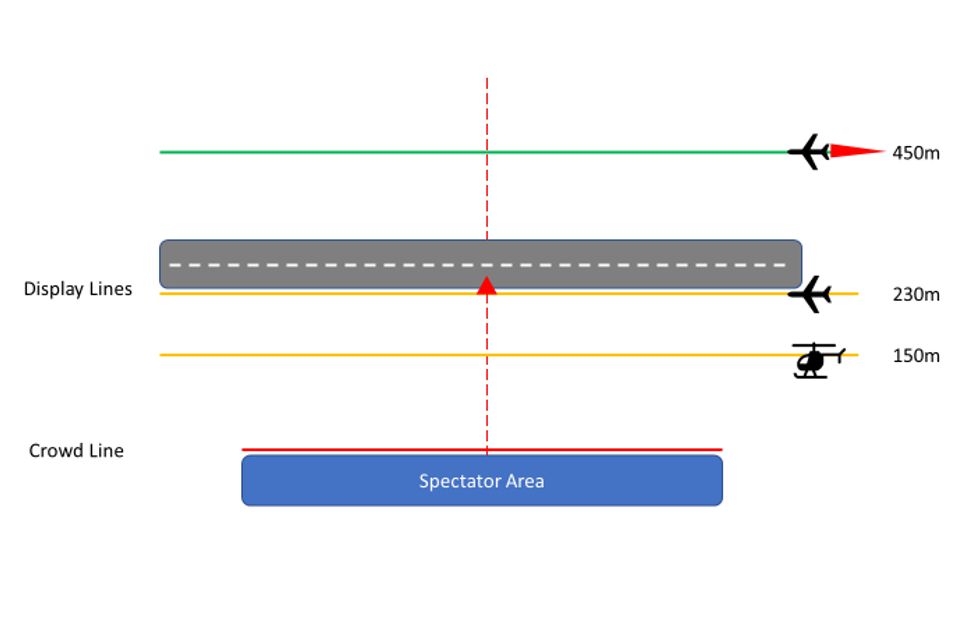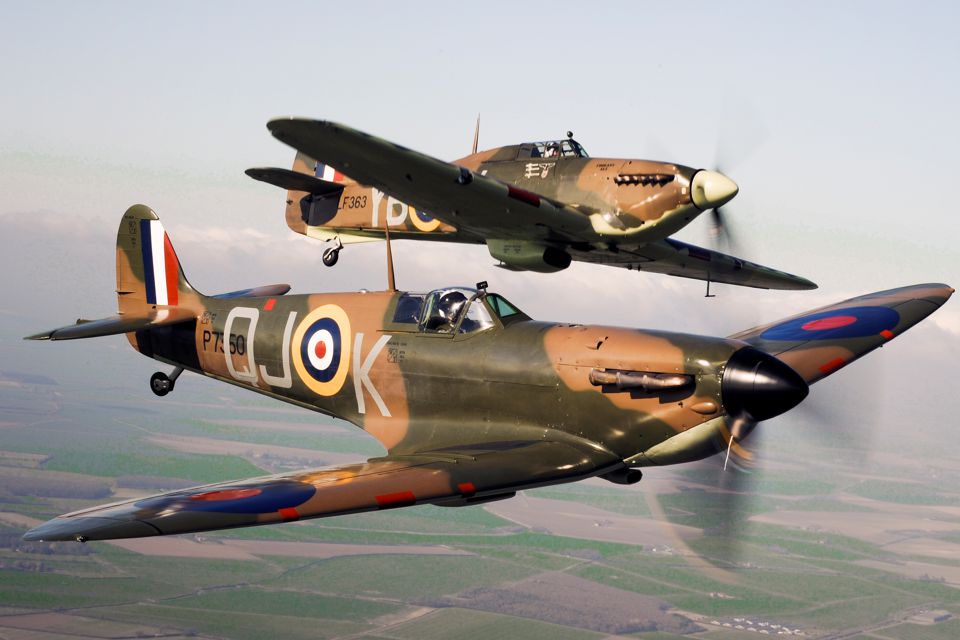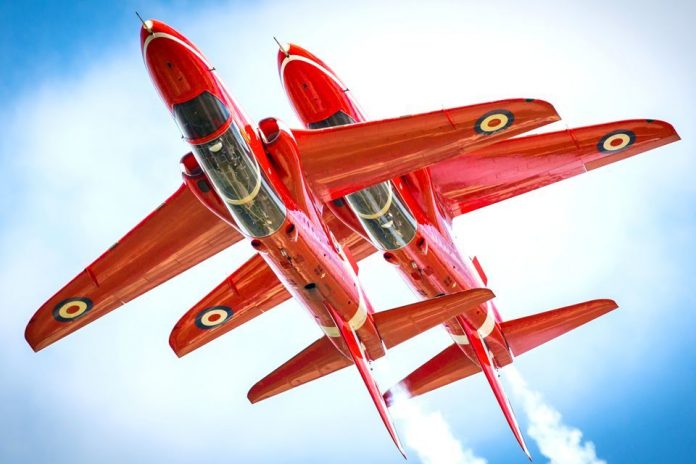The tragic loss of eleven lives following the crash of a civilian owned and operated Hawker Hunter while display flying near Shoreham on 22 August 2015 brought the safety of flying displays into sharp focus.
Though time has passed, that focus has not diminished. In their role as air safety regulators, the Civil Aviation Authority (CAA) and Military Aviation Authority (MAA) continue to strive to improve safety at flying displays.
Notwithstanding the significantly disruptive impact the coronavirus pandemic has had on the 2020 display season, in any normal year, flying displays are incredibly well attended.
As one of the most popular outdoor attractions in the UK, with around 5 million spectators entertained by them annually, the CAA and MAA take the regulation and assurance of these events extremely seriously.
The regulatory framework for flying displays and display flying within the UK is detailed within the following documents:
What arrangements are in place for the safe delivery of flying displays
There are two distinct aspects which influence safety at flying displays.
Firstly, the planning, management, organisation and execution of the event itself, which focusses on health, safety and environmental protection considerations, ensuring that the aircraft are adequately displaced from spectators; and, secondly, the participation of suitably qualified aircrew, who are considered competent to safely demonstrate the full range of their aircraft capabilities within the display flying environment.
The size and complexity of flying displays varies considerably, whether it be the geography, airspace, number and variety of participating aircraft, proximity to built-up areas, as well as the management of spectators and third parties.
These are all key considerations for each venue used. To reflect this, each event is given a ‘tier’, aligned to which there is a tiered accreditation system in place to ensure that the key individual, charged with the safe coordination of the display flying activity conducted at each event, is suitably qualified and experienced. This individual is designated as the Flying Display Director (FDD).
The FDD focusses on the safe delivery of the flying display, integrating display flying elements into whatever other entertainment is being provided as part of an event.
The event organiser assumes responsibility for the wider planning, management, organisation and execution of the event.
These two appointments are key to the safe delivery of the event as a whole and are governed by a core set of regulations promulgated by the CAA and MAA, which are designed to safely bind the flying activity due to be conducted.
Pictured are The Black Cats Helicopter Display Team and their Wildcat Helicopter.
MOD Crown Copyright.
So how are FDDs provided with appropriate qualifications to deliver an event
The CAA and MAA run a joint FDD accreditation course. This involves a two day interactive assessment of each candidate’s understanding of the regulations and incorporates a variety of planning considerations required to ensure they are suitably qualified and experienced to deliver an event of the appropriate tier.
To ensure each candidate has a suitable understanding of the key regulations, a joint CAA / MAA accreditation panel considers their flying display related experience, their performance in a pre-course, scenario based, planning exercise, their interaction during the course and the results of their end of course examination.
Successful candidates are authorised to deliver events of varying complexity (tiers) based on their experience as well as their performance during the course.
The FDD qualification is valid for 3 years, subject to the safe delivery of an event within 2 years of being awarded the accreditation.
FDD mentors are appointed by the regulators based on their experience and competence in the role. The mentors help those FDD with limited experience to develop the competence required to conduct more complex events prior to them being assessed for higher tier accreditation.
What about the qualification of display pilots that perform at flying displays across the UK
Civilian display pilots are required to demonstrate their display flying related competence to CAA appointed display authorisation evaluators, who are certified to award display authorisations on behalf of the CAA in accordance with CAP 1724.
The display authorisation specifies the manoeuvres that can be conducted by pilots operating particular groups and categories of aircraft along with any associated limitations.
Similarly, military display pilots are required to demonstrate the requisite level of flying display competence before they are awarded a public display authority from their Chain of Command, usually a suitably experienced and qualified Aviation Duty Holder or Accountable Manager (Military Flying).
There are also regulations and orders in place to ensure suitable work up training and currency flying is conducted by civilian and military display pilots prior to any display flying being conducted at public events.
Display pilot competencies are assessed on an annual basis before their display flying qualifications can be renewed.
How do FDDs and display pilots ensure they deliver a safe flying display
The FDD must first identify the area within which they plan to locate spectators (spectator area) and ensure it is suitably displaced from the area within which display pilots will fly (display area).
Display pilots will use an easily identifiable display line which the FDD is required to mark and is set at a minimum separation distance from the forward edge of the spectator area (more commonly referred to as the crowd line).
The minimum separation distance between the crowd line and the display line is normally 230 metres, but this can be extended to 450 metres for aircraft that conduct manoeuvres at speeds in excess of 300 knots, or reduced to 150 metres for helicopters and light aircraft (see Figure 1).

Figure 1 – Display Area Layout
Display pilots are permitted to fly down to minimum heights within the display area as specified on their display authorisation or public display authority.
The minimum heights vary depending on the type of aircraft involved, the display pilot’s approval and hazards within the display area itself.
The FDD is required to brief display pilots on the flying related risks and hazards associated with each specific event and is responsible for the safe coordination and necessary adjustments to the flying display programme on the day.
Display pilots are responsible for the choreography of their display routine, which must ensure the aircraft retains adequate energy throughout a manoeuvre to maintain safe separation from the spectator area.
Does anyone check the arrangements in place for the venue prior to the event being conducted
For civilian events, the CAA issue a flying display permission which takes into consideration the risks associated with the event, configuration of the display area, the display lines, spectator area and the aircraft involved.
Similarly, responsibility for adherence to regulations at a military venue lies with the Head of Establishment (HoE) (typically the Station Commander); the event organiser and FDD plan, manage, organise and deliver the event on behalf of the HoE.
By carrying out regulatory inspections, the CAA and MAA conduct assurance against the requirements detailed in the associated regulatory publications.
These regulations cover a variety of aspects associated with the planning, management, organisation and delivery of each event.
Frequently, there are civilian and military participants involved in the same flying display and, as a result, the CAA and MAA conduct assurance inspections against both and, in some cases, undertake the inspections together.
Does assurance activity make any difference to the way in which events are organised and run
The CAA and MAA work closely with the regulated community to assure the safe delivery of events.
Every inspection presents an opportunity for the regulators to see how event organisers, FDD and their subordinate Flying Control Committees (which contain experienced personnel familiar with the aircraft types involved in the display) run an event.
It also enables the regulators to assess how the event teams interact with the display pilots and monitor their adherence to the restrictions associated with the display venue.
The inspections also provide opportunities for the regulators to discuss issues with all those involved, raise awareness and share good practice, which in turn helps to promote safety.

Spitfire P7350 (front) flies alongside Hurricane LF363 (back).
MOD Crown Copyright.
How are lessons identified and communicated to the flying display regulated community
Every event presents a different set of challenges and it is important that lessons identified are used to aid the planning and management of future displays.
Flying display symposia are held before and after each display season.
These are arranged by the CAA and MAA and bring together display pilots, FDD, Flying Control Committees, event organisers and others involved in the planning, management, organisation and delivery of events.
Whether to reflect on the display season that has just concluded, or in preparation for the display season ahead, these provide the opportunity to discuss safety related issues that should be considered when running an event, while sharing good practice and raising awareness.
Mid-way through the display season, the regulators also compile a combined update for the regulated community.
The update is used to share lessons identified during the season to date, promulgate safety related information and address any general queries or concerns received from the regulated community.
What about the planning activity and regulatory preparations made for display season 2020
This year, the 2020 pre-season flying display symposium was cancelled due to lockdown restrictions imposed at the onset of the coronavirus pandemic, which has gone on to directly affect many public flying display events held worldwide, as well as much routine aviation activity. As a result, regulators have had to assess the extent of the impact this has had on the regulated community.
As coronavirus restrictions begin to be eased, some flying display events have managed to go ahead, albeit with new and innovative solutions in place to ensure government advice is adhered to and social distancing achieved.
The regulators must ensure safety related messages, that would have been promulgated at the pre-season flying display symposium, are disseminated to the wider regulated community rather than risk impacting the flying display safety standards that have been improving over the last few years.
Current social distancing restrictions are unlikely to support any form of sizeable gathering along the lines of a symposium.
Instead, the regulator has disseminated the information in the form of a written update, produced for the benefit of the entire flying display community, thereby not just limiting it to those who would routinely attend the symposium. This was released by the CAA in July 2020.
Summary
The ultimate aim of the regulators is to promote safety and avoid a future flying display incident that results in the tragic loss of life.
With flying displays being one of the most popular spectator pastimes in the UK, it is hoped this article has provided the reader with an insight into how flying display events and their associated activities are regulated and assured.
The CAA and MAA work hand in hand to ensure FDDs and display pilots are suitably qualified and afforded the requisite information required to plan, organise, manage and deliver safe flying displays within the UK.
Events are regularly inspected to assure compliance with the regulations and guidance, designed to keep the general public safe and to share lessons identified and good codes of practice with all those involved in the delivery of these events.
Importantly, the regulators will seek to work closely with the regulated community as it gradually recovers from the coronavirus pandemic.







